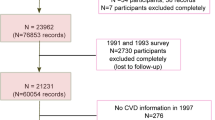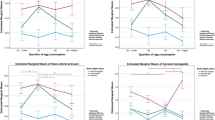Abstract
Objective: To investigate the association between habitual fish consumption and a continuous measure of glycaemia.
Design: Cross-sectional study.
Setting: EPIC-Norfolk, a population-based cohort study of diet and chronic disease.
Subjects and methods: In all, 4500 men and 5509 women, aged 40–78 y, without self-reported diabetes. Diet was assessed by a semiquantitative food frequency questionnaire, and glycaemia was measured by glycated haemoglobin.
Results: In women only, in analyses adjusted for age, the HbA1c level was positively associated with eating fried fish and inversely associated with eating oily fish (b=0.036, 95% confidence interval (CI): 0.0033, 0.069; and b=−0.046, 95% CI:−0.086, −0.0064 respectively). These associations were attenuated by adjustment for family history of diabetes, smoking status and physical activity level, but the association with fried fish remained statistically significant (b=0.033, 95% CI: 0.00056, 0.066). Adjusting for total energy, alcohol, fruit and vegetable intakes resulted in further attenuation and both associations were no longer statistically significant. In men, there was no evidence that HbA1c level was associated with fish consumption.
Conclusions: The study found no evidence of an association between fish consumption and HbA1c after taking other lifestyle factors into account.
Sponsorship: NJW is a Wellcome Trust Senior Clinical Research Fellow.
This is a preview of subscription content, access via your institution
Access options
Subscribe to this journal
Receive 12 print issues and online access
$259.00 per year
only $21.58 per issue
Buy this article
- Purchase on Springer Link
- Instant access to full article PDF
Prices may be subject to local taxes which are calculated during checkout

Similar content being viewed by others
References
Adler AI, Boyko EJ, Schraer CD & Murphy NJ (1994): Lower prevalence of impaired glucose tolerance and diabetes associated with daily seal oil or salmon consumption among Alaska Natives. Diabetes Care 17, 1498–1501.
Bingham SA, Margetts BM, Gill C, Welch A, Cassidy A, Runswick SA, Oakes S, Lubin R, Thurnham DI, Key TJ, Roe L, Khaw KT & Day NE (1997): Validation of dietary assessment methods in the UK arm of EPIC using weighed records, and 24-hour urinary nitrogen and potassium and serum vitamin C and carotenoids as biomarkers. Int. J. Epidemiol. 26 (Suppl 1), S137–S151.
Bingham SA & Nelson M (1991): Assessment of food consumption and nutrient intake. In Design concepts in Nutritional Epidemiology, BM Margetts & M Nelson (eds)., pp 153–191. Oxford: Oxford University Press.
Bjerregaard P, Pedersen HS & Mulvad G (2000): The associations of a marine diet with plasma lipids, blood glucose, blood pressure and obesity among the Inuit in Greenland. Eur. J. Clin. Nutr. 54, 732–737.
Borkman M, Storlien LH, Pan DA, Jenkins AB, Chisholm DJ & Campbell LV (1993): The relation between insulin sensitivity and the fatty-acid composition of skeletal-muscle phospholipids. N. Engl. J. Med. 328, 238–244.
Chan DC, Watts GF, Barrett PHR, Beilin LJ & Mori TA (2002): Effect of atorvastatin and fish oil on plasma high-sensitivity C-reactive protein concentrations in individuals with visceral obesity. Clin. Chem. 48, 877–883.
Day N, Oakes S, Luben R, Khaw KT, Bingham S, Welch A & Wareham N (1999): EPIC-Norfolk: study design and characteristics of the cohort. European Prospective Investigation of Cancer. Br. J. Cancer 80 (Suppl 1), 95–103.
de Deckere EA, Korver O, Verschuren PM & Katan MB (1998): Health aspects of fish and n-3 polyunsaturated fatty acids from plant and marine origin. Eur. J. Clin. Nutr. 52, 749–753.
Dewailly E, Blanchet C, Gingras S, Lemieux S, Sauve L, Bergeron J & Holub BJ (2001a): Relations between n-3 fatty acid status and cardiovascular disease risk factors among Quebecers. Am. J. Clin. Nutr. 74, 603–611.
Dewailly E, Blanchet C, Lemieux S, Sauve L, Gingras S, Ayotte P & Holub BJ (2001b): n-3 Fatty acids and cardiovascular disease risk factors among the Inuit of Nunavik. Am. J. Clin. Nutr. 74, 464–473.
Feskens EJ, Bowles CH & Kromhout D (1991): Inverse association between habitual fish intake and risk of glucose intolerance in normoglycemic elderly men and women. Diabetes Care 14, 935–941.
Grundt H, Nilsen DW, Hetland O, Aarsland T, Baksaas I, Grande T & Woie L (1995): Improvement of serum lipids and blood pressure during intervention with n-3 fatty acids was not associated with changes in insulin levels in subjects with combined hyperlipidaemia. J. Intern. Med. 237, 249–259.
Harding AH, Sargeant LA, Khaw KT, Welch A, Oakes S, Luben RN, Bingham S, Day NE & Wareham NJ (2002): Cross-sectional association between total level and type of alcohol consumption and glycosylated haemoglobin level: the EPIC-Norfolk Study. Eur. J. Clin. Nutr. 56, 882–890.
Khaw K-T, Wareham N, Luben R, Bingham S, Oakes S, Welch A & Day N (2001): Glycated haemoglobin, diabetes, and mortality in men in Norfolk cohort of European Prospective Investigation of Cancer and Nutrition (EPIC-Norfolk). BMJ 322, 15–18.
Kromann N & Green A (1980): Epidemiological studies in the Upernavik District, Greenland. Acta. Med. Scand. 208, 401–406.
Lavigne C, Tremblay F, Asselin G, Jacques H & Marette A (2001): Prevention of skeletal muscle insulin resistance by dietary cod protein in high fat-fed rats. Am. J. Physiol. Endocrinol. Metab. 281, E62–E71.
Lovegrove JA, Brooks CN, Murphy MC, Gould BJ & Williams CM (1997): Use of manufactured foods enriched with fish oils as a means of increasing long-chain n-3 polyunsaturated fatty acid intake. Br. J. Nutr. 78, 223–236.
Mori TA, Bao DQ, Burke V, Puddey IB, Watts GF & Beilin LJ (1999): Dietary fish as a major component of a weight-loss diet: effect on serum lipids, glucose, and insulin metabolism in overweight hypertensive subjects. Am. J. Clin. Nutr. 70, 817–825.
Mori TA, Burke V, Puddey IB, Watts GF, O'Neal DN, Best JD & Beilin LJ (2000): Purified eicosapentaenoic and docosahexaenoic acids have differential effects on serum lipids and lipoproteins, LDL particle size, glucose, and insulin in mildly hyperlipidemic men. Am. J. Clin. Nutr. 71, 1085–1094.
National Diabetes Data Group (1996): Diabetes in America, 2nd Edition. Bethesda, MD: National Institutes of Health.
National Food Survey Committee (1982): Annual Report of Household Food Consumption and Expenditure 1980. London: Her Majesty's Stationery Office.
Riboli E & Kaaks R (1997): The EPIC Project: rationale and study design. European Prospective Investigation into Cancer and Nutrition. Int. J. Epidemiol. 26 (Suppl 1), S6–S14.
Sargeant LA, Khaw KT, Bingham S, Day NE, Luben RN, Oakes S, Welch A & Wareham NJ (2001a): Cigarette smoking and glycaemia: the EPIC-Norfolk Study. Int. J. Epidemiol. 30, 547–554.
Sargeant LA, Khaw KT, Bingham S, Day NE, Luben RN, Oakes S, Welch A & Wareham NJ (2001b): Fruit and vegetable intake and population glycosylated haemoglobin levels: the EPIC-Norfolk Study. Eur. J. Clin. Nutr. 55, 342–348.
Singer DE, Nathan DM, Anderson KM, Wilson PW & Evans JC (1992): Association of HbA1c with prevalent cardiovascular disease in the original cohort of the Framingham Heart Study. Diabetes 41, 202–208.
Soriguer F, Serna S, Valverde E, Hernando J, Martin Reyes A, Soriguer M, Pareja A, Tinahones F & Esteva I (1997): Lipid, protein, and calorie content of different Atlantic and Mediterranean fish, shellfish, and molluscs commonly eaten in the south of Spain. Eur. J. Epidemiol. 13, 451–463.
Standing SJ & Taylor RP (1992): Glycated haemoglobin: an assessment of high capacity liquid chromatographic and immunoassay methods. Ann. Clin. Biochem. 29, 494–505.
Storlien LH, Baur LA, Kriketos AD, Pan DA, Cooney GJ, Jenkins AB, Calvert GD & Campbell LV (1996): Dietary fats and insulin action. Diabetologia 39, 621–631.
Toft I, Bonaa KH, Ingebretsen OC, Nordoy A & Jenssen T (1995): Effects of n-3 polyunsaturated fatty acids on glucose homeostasis and blood pressure in essential hypertension. A randomized, controlled trial. Ann. Intern. Med. 123, 911–918.
Tremblay F, Lavigne C, Jacques H & Marette A (2003): Dietary cod protein restores insulin-induced activation of phosphatidylinositol 3-kinase/Akt and GLUT4 translocation to the T-tubules in skeletal muscle of high-fat-fed obese rats. Diabetes 52, 29–37.
Unwin N, Alberti K, Bhopal R, Harland J, Watson W & White M (1998): Comparison of the current WHO and new ADA criteria for the diagnosis of diabetes mellitus in three ethnic groups in the UK. Diabet. Med. 15, 554–557.
Vessby B (2000): Dietary fat and insulin action in humans. Br. J. Nutr. 83, 1s91–1s96.
Wareham NJ, Jakes RW, Rennie KL, Schuit J, Mitchell J, Hennings S & Day NE (2003): Validity and repeatability of a simple index derived from the short physical activity questionnaire used in the European Prospective Investigation into Cancer (EPIC) study. Pub. Health Nutr. (in press).
Willett WC, Sampson L, Stampfer MJ, Rosner B, Bain C, Witschi J, Hennekens CH & Speizer FE (1985): Reproducibility and validity of a semiquantitative food frequency questionnaire. Am. J. Epidemiol. 122, 51–65.
Young TK, Schraer CD, Shubnikoff EV, Szathmary EJ & Nikitin YP (1992): Prevalence of diagnosed diabetes in circumpolar indigenous populations. Int. J. Epidemiol. 21, 730–736.
Author information
Authors and Affiliations
Contributions
Guarantor: NJ Wareham.
Contributors: A-HH and NJW contributed to the study concept, analysis and interpretation of the data and the drafting of the manuscript. K-TK, SAB, NED and NJW are principal investigators of EPIC-Norfolk. AW and RNL contributed to the study design and data collection and management. All authors contributed to the revision and drafting of the final version.
Corresponding author
Rights and permissions
About this article
Cite this article
Harding, AH., Day, N., Khaw, KT. et al. Habitual fish consumption and glycated haemoglobin: The EPIC-Norfolk Study. Eur J Clin Nutr 58, 277–284 (2004). https://doi.org/10.1038/sj.ejcn.1601779
Received:
Revised:
Accepted:
Published:
Issue Date:
DOI: https://doi.org/10.1038/sj.ejcn.1601779
Keywords
This article is cited by
-
Diet and glycosylated haemoglobin in the 1946 British birth cohort
European Journal of Clinical Nutrition (2009)
-
The Pro12Ala polymorphism of the PPAR-γ2 gene affects associations of fish intake and marine n−3 fatty acids with glucose metabolism
European Journal of Clinical Nutrition (2008)



